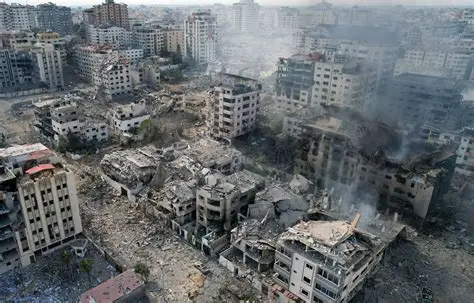Israeli airstrikes in Gaza have killed 33 people and injured many more, according to medical officials, in one of the most serious escalations of violence since the United States‑backed ceasefire came into effect last month. The renewed bombardment has raised fears that the fragile truce could collapse entirely, with both sides accusing the other of violating its terms.
Officials at Nasser hospital in Khan Younis reported receiving the bodies of 17 people, among them five women and five children, after four Israeli strikes targeted tents sheltering displaced families. In Gaza City, medical staff said two further strikes killed 16 people, including seven children and three women. The attacks have left communities reeling, with survivors describing scenes of devastation and despair.
Israel stated that the strikes were launched after its soldiers came under fire in Khan Younis on Wednesday, though no casualties were reported among its forces. Hamas condemned the attacks as a “shocking massacre” and denied firing towards Israeli troops. The group accused Israel of deliberately undermining the ceasefire, which was intended to ease humanitarian suffering and pave the way for political negotiations.
For many Palestinians, the violence has reinforced the sense that the two‑year war has never truly ended. Officials in Gaza say more than 300 people have been killed by Israeli strikes since the ceasefire was announced, averaging more than seven deaths a day. Residents describe living under constant fear, with bombardments resuming whenever hope begins to return. “My daughter kept asking me all night, ‘Will the war come back?’ Every time we try to regain hope, the shelling starts again. When will this nightmare end?” said Lina Kuraz, 33, from the Tuffah neighbourhood in Gaza City.
Others echoed the sentiment. Mohammed Hamdouna, 36, displaced from northern Gaza to a tent in al‑Mawasi, said: “The intensity of the death toll has decreased, but martyrs and shelling happen every day. We are still living in tents. The cities are rubble; the crossings are still closed, and all the basic necessities of life are still lacking.” His words highlight the dire humanitarian conditions that persist despite international efforts to stabilise the territory.
Qatar, which has played a key mediating role throughout the conflict, condemned the Israeli strikes as “brutal” and warned they represented “a dangerous escalation that threatens to undermine the ceasefire agreement”. The statement reflects growing concern among regional actors that the truce may unravel before any meaningful progress is made.
On Monday, the United Nations Security Council endorsed President Donald Trump’s plan for Gaza, which includes deploying an international stabilisation force and outlining a possible path towards a sovereign Palestinian state. Yet significant obstacles remain. Questions persist over how Hamas will be compelled to relinquish its weapons, which nations will contribute troops to the peacekeeping mission, and how humanitarian aid will reach Gaza without Israel lifting restrictions on supplies. Hamas continues to hold the remains of three hostages, while Israeli forces retain control of more than half of Gaza, having withdrawn from some positions at the time of the ceasefire. The territory is now divided by what is referred to as the “yellow line”.
The Gaza health ministry has reported more than 300 deaths since the ceasefire began, underscoring the fragility of the agreement. Each side has accused the other of breaching its terms, which include increasing the flow of aid into Gaza and returning hostages, dead or alive, to Israel. The mistrust has made progress difficult, with civilians bearing the brunt of the continued violence.
The war was triggered in October 2023 when Hamas‑led militants launched a surprise attack into Israel, killing about 1,200 people, mostly civilians, and abducting 251. Israel responded with a massive offensive that has killed more than 69,000 Palestinians, according to Gaza officials, most of them civilians. Thousands more remain buried under rubble, with recovery efforts hampered by ongoing strikes and restrictions on aid.
The latest escalation in Gaza coincided with Israeli airstrikes in southern Lebanon on Wednesday. A day earlier, an Israeli strike killed 13 people in the Palestinian refugee camp of Ein el‑Hilweh, marking the deadliest Israeli attack on Lebanon since a ceasefire in the Israel‑Hezbollah conflict a year ago. The widening scope of Israeli military action has raised fears of a broader regional conflagration, with Lebanon now drawn further into the cycle of violence.



